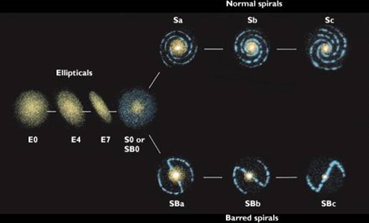
Irr I included irregular galaxies that showed some hint of organised structure (such as the Large and Small Magellanic Clouds), while Irr II were those irregulars that were completely disorganised.

They share the same range of classifications as non-barred spirals – from Type SBa (early) to SBc (late) – according to the prominence of the bulge and the winding of the spiral arms.Ī later extension to the Hubble classification was the inclusion of irregular galaxies in two classes: In bars, the spiral arms do not start directly from the bulge, but from an extended bar of stars that passes through the bulge. Type Sc (late) spirals have the least prominent bulges (bulge-to-disk luminosity ~ 0.05), and loosely wound arms (pitch angle ~ 0.18) that are resolved into clumps of stars and HII regions. Type Sa (early) spiral galaxies have prominent bulges (bulge to disk luminosity ~0.3), tightly wound arms (pitch angle ~ 0.6), and the stars in the spiral arms are distributed very smoothly. Sa galaxies have very tightly wound arms around. Spiral galaxys are divided into three main types depending on how tightly wound their spiral arms are: Sa, Sb and Sc. In a spiral galaxy, the stars, gas and dust are gathered in spiral arms that spread outward from the galaxys center.

Spiral galaxies are classed from ‘early-type’ to ‘late-type’ according to the ratio of the luminosity of the bulge compared with the disk, and the amount of winding of the spiral arms. Spiral galaxies get their name from the shape of their disks. These galaxies show prominent bulges, but no spiral arms. Located in the fork of the Hubble classification diagram and intermediate between the elliptical and spiral galaxies are the S0/SB0 galaxies. E0 are considered ‘early-type’ ellipticals and E7 are ‘late-type’ ellipticals. Observed values range from E0 (circular cross section – a spherical galaxy) to E7 (the most flattened). Where a = semi-major axis and b = semi-minor axis of the ellipse. Hubble’s elliptical galaxies were classed according to the ellipticity of the galaxy, and given a Hubble type:

Although this is now known to be a false interpretation, the terms ‘early-type’ and ‘late-type’ are still used regularly by astronomers in the manner described below, and when discussing broad galaxy types. The Hubble Classification scheme for galaxies, often referred to as the “tuning fork” diagram.Įdwin Hubble originally identified an evolutionary sequence for the galaxies (from early-type to late-type) as one moved from left to right across the diagram.


 0 kommentar(er)
0 kommentar(er)
